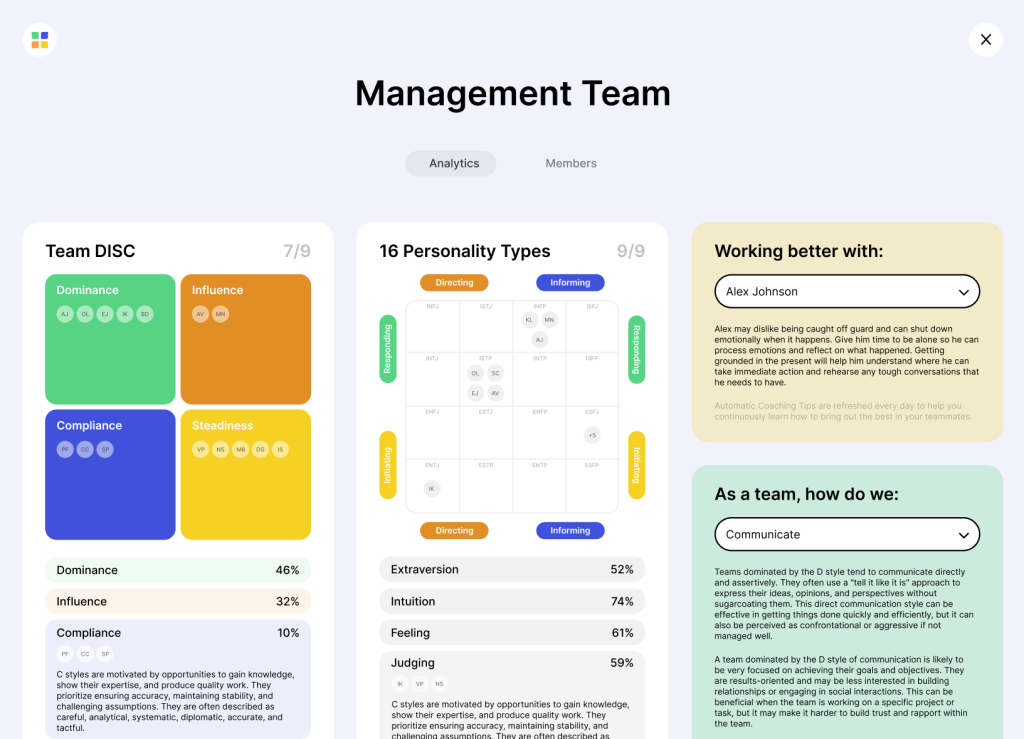The HBDI Test Alternative: Free Online Alternative Assessment
Help your team members work better together by creating an integrated analysis of all your team personality types
The HBDI Test unveils the mysteries of our brain’s quadrants. Are you ready to explore your dominant thinking patterns?
Every individual thinks in different ways. The way you process thoughts impacts virtually every aspect of your life, including your relationships, career, and even your values. With thinking styles being such a key aspect of your everyday life, learning about them becomes crucial for long-term success and happiness.
However, few online assessments that give you deep insights into your thinking exist. Out of those that are available, many are confusing to interpret. Thankfully, one accessible assessment provides a fantastic overview of your cognitive preferences: the HBDI.
In this guide, we will cover what the HBDI test is, how it stands out from other assessments, and ways it can benefit your life.
Overview of the HBDI Test
The HBDI assessment has been widely renowned for over 35 years. Researchers, writers, and test-takers alike all praised the test for decades. However, this does not mean the HBDI remained the same over the years.
Below, we discuss the legacy of the HBDI test, as well as several iterations it has undergone recently.
Brief Overview
The HBDI, or the Herrmann Brain Dominance Instrument, was born from the visionary ideas of William “Ned” Herrmann. He is now known as the father of brain dominance technology.
Nearly 4 decades ago, he began researching how certain thinking patterns impact business. During this research, he realized the brain can be divided into 4 main quadrants with different brain functions.
Although he initially studied neuroscience as it applies to specific business problems, he later turned his observations into an assessment that can be taken by anyone, including students, new employees, and executives. That test is now known as the HBDI and the Herrmann Whole Brain test.
The Test’s Progression
Although many test-takers began praising the HBDI as soon as it was released, the test has changed over time. It has improved as the organization collected more data from test-takers.
For example, the Whole Brain test is now being paired with 8 mini learning sessions to help test-takers better understand their results. There are new videos, games, and self-reflection exercises that make learning about your thinking preferences fun.
There have also been a few stylistic updates to the HBDI, including slightly updating the language and the company presence. The test still adheres to the original principles and ideas outlined by Herrmann, though.
How Does the Herrmann Brain Dominance Instrument (HBDI) Assessment Work?
Understanding how the HBDI works and the basic principles behind this assessment is crucial for getting accurate results. It allows you to gain a deeper insight into what your thinking preferences results truly mean.
Here is a general overview of the HBDI test quadrants and each quadrant means:
In-Depth Analysis
There are four quadrants in the HBDI. Each of these quadrants has a unique impact on your thinking approach. These quadrants are:
- The green quadrant. It represents organization, being detail-oriented, and planned thinking approaches.
- The yellow quadrant. The yellow quadrant is most active in people with intuitive thinking, who integrate knowledge (combine facts for bigger picture views on the world), and holistic analysis.
- The blue quadrant. Quadrant A or the blue quadrant represents logical thinking, being analytical, and focusing decisions based on facts.
- The red quadrant. The red quadrant or Quadrant C relates to emotional thinking, interpersonal skills, and using feelings in decision-making processes.
Help your team members work better together by creating an integrated analysis of all your team personality types
The Process of Taking the HBDI Test
Many online personality assessments or energy level tests tend to be confusing. However, the HBDI test is different. The test’s developers specifically designed the test to be understood by lay individuals.
Still, it is important to understand how the test grades results so you can create the best action plan afterward.
Some of the main elements of the HBDI test process you should be aware of include:
Test Design
The HBDI assessment is a powerful tool to help you better understand your brain in terms of thinking processes. It covers a variety of queries, including questions that relate to your goals, how you react to certain scenarios and behavior styles.
Generally, the test will give you several adjectives to describe yourself in a certain setting. These mini-simulations help the test understand how you think under pressure and in regular settings.
After getting these cognitive style indicators, the test can more accurately outline your thinking patterns.
Decoding the Test Results
Simply taking the HBDI can be an enriching and exciting experience. Nonetheless, the true magic happens after you find out your results and analyze them.
You will be given 4 scores in your results. Each of the scores represents how much you think and how comfortable you are with each of the 4 quadrants. These scores fluctuate between 8 and 189.
The higher your score is, the more often you use that quadrant, and the bigger role it plays in your overall thinking patterns.
Applications of the HBDI Assessment
After you understand what your test results mean, it is time to apply them to the real world. For some assessments, this may be a confusing process. However, the HBDI test has many real-world applications.
A few of these important applications of the HBDI test include:
Personal Development
Some of the greatest benefits that come with the HBDI assessment can all be tied to self-growth and improvement. By learning about your thinking patterns, you become more self-aware. This allows you to understand your natural thinking strengths and weaknesses better, as well as improves decision-making skills.
You can also improve your relationships by learning more about your thinking patterns. This is so since you will become more understanding of your thinking flaws, and thus look out for them more often, thus preventing uncomfortable situations.
Taking this test can even boost qualities like discipline, confidence, leadership, communication, and self-control. These are all qualities tied to having more self-awareness.
Organizational Purposes
Although this test certainly helps individuals, its benefits do not stop there. They can also be applied on a larger scale to teams and large organizations.
One key benefit that organizations gain from the HBDI assessment comes during the recruiting process. HR managers can better evaluate how well a potential team member fits into the role with this thinking style assessment.
Additionally, the test boosts team collaboration. If people better understand each other’s thinking styles and work in teams that have all 4 styles represented, the work is done more effectively. As a result, the entire team can be more efficient and innovative.
Can You Use the Herrmann Brain Dominance Instrument Assessment for Recruitment?
The Herrmann Brain Dominance Instrument test has a wide array of fields it can apply. One commonly used method organizations use the HBDI centers around recruitment.
The HBDI gives recruiters a plethora of key insights. For one, they can hire individuals who best fit their team’s thinking patterns. It helps identify potential weak spots for teams, so managers can hire individuals with diverse thinking patterns to fill those gaps. Doing so helps the team be more productive and efficient.
How Much Does the HBDI Assessment Cost?
After accuracy, the next major concern test-takers tend to have revolves around cost. HBDI test pricing depends on how many assessments you are ordering. The more you order, the less each test costs.
Generally, the cost ranges from approximately $125 to $325 per test depending on how many assessments you purchase and which company you purchase from.
Help your team members work better together by creating an integrated analysis of all your team personality types
Is the HBDI Test Scientifically Validated?
One of the main worries individuals have with tests like the HBDI is whether or not science supports such testing. Over the years, many tests have been called pseudo-scientific. However, the HBDI is not one of them.
This test has decades of research supporting it. The test was developed by a renowned and respected researcher. Thousands of individuals have noted their positive experiences with the test. Even major organizations like Hilton, NASA, and Stanford utilize the HBDI system.
In addition, several recent studies have been done to validate the test’s accuracy. Those studies can be accessed here through Herrmann.
How Long Does the HBDI Test Take to Finish?
The test contains 116 questions. Most individuals can expect to be done with the test in approximately 90 minutes, although it can be taken in several sittings.
Help your team members work better together by creating an integrated analysis of all your team personality types
Disclaimer: All trademarks mentioned on this page or any other page on the BestPersonalityTests.com website are the property of their respective owners. The information as well as sample tests on this page or any other page on the BestPersonalityTests.com website are provided for informational and illustrative purposes only. They are not meant as substitutes for the original assessments and do not intend to diminish the value of the mentioned companies or their services. The editorial team strives to be accurate in the information presented and to keep it as up-to-date as possible, however, it is possible that some of it is outdated. In such cases, please contact the editorial team with suggested updates or corrections.


